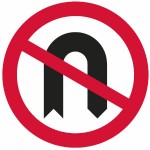Most drivers will make a U-turn when they realise that they have just passed a road that they should have taken, or realise that they are traveling in the wrong direction.
What is a U-turn?
The definition of a U-turn means that you are turning the car around in the road without the need to reverse.
It is done in one complete manoeuvre to travel back in the opposite direction you originally came from. An alternative to a U-turn is a turn in the road or otherwise known as a 3 point turn.
Although it is legal to make U-turns on many of the UK roads, it is important to beware of road signs prohibiting U-turns and not to inconvenience other road users and become a hazard.
U-turn laws
Red circular road signs are giving orders. It is not permitted by law to make a U-turn where such signs exist. Although it may appear an ideal location to make a U-turn where such signs are placed, they are located in such areas to prevent accidents. Other than roads marked with a no U-turn sign, it is also illegal to make U-turns on motorways and one-way streets.

Illegal U-turn penalties
Making an illegal manoeuvre, or U-turn in a prohibited area can see a driver issued with a Fixed Penalty Notice (FPN), three penalty points on their licence and a £60 fine. It doesn’t necessarily need to be in a prohibited area either.
Making a U-turn within a location that is legally permitted may still see a driver issued with a FPN where they represent a danger to other road users or pedestrians. This would however come under the offence of careless driving and not for specifically making a U-turn.
Certain local councils are able to issue a Penalty Charge Notice (PCN) to motorists making an illegal manoeuvre such as a U-turn, though a PCN is non-endorsable and only a fine is issued.
Safe U-turns
Before making a U-turn, always ask yourself:
- Is it safe to perform the manoeuvre?
- Is it legal?
- Will I inconvenience other road users or pedestrians?
- Can I see clearly or should I pull up on the left initially?
- Are there any cyclists or motorcycles that are difficult to see?
- Is the road wide enough to perform the U-turn safely?
If you are in doubt, do not attempt the U-turn and find an alternative method for turning your vehicle around. Before attempting to make a U-turn, all-round observation is essential. It is potentially a dangerous manoeuvre to carry out at places other than large roundabouts as you typically need to cross lines of opposing traffic and that other drivers will not be expecting you to make a U-turn.
The safest method for making a U-turn is pull up on the left initially – though don’t forget to use your mirrors and signal before doing so. Once stopped, cancel your signal and take a good look in your mirrors, check the blind spot and signal to the right when you intend on moving off. Be particularly aware of motorcycles and cyclists who are difficult to see before moving off.
Mini roundabouts can be particularly dangerous to make a U-turn as drivers are not expecting you to follow round and take the same exit you entered the roundabout with. When making a U-turn, never mount a kerb.

I did a u-turn on a smallish roundabout and it caused road rage.